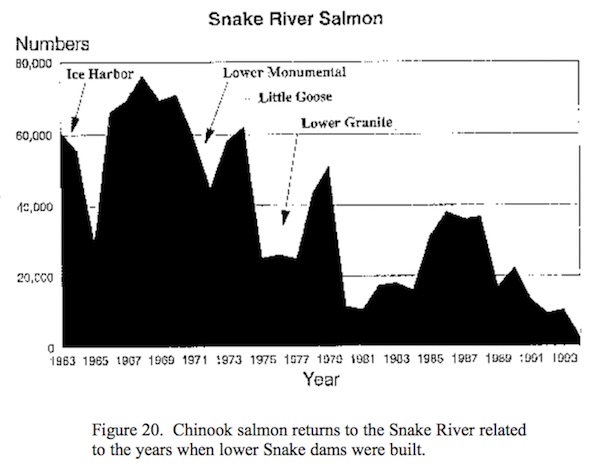forum
library
tutorial
contact

Leave No One Behind
by Roger RankinIdaho State Journal, February 15, 2021
|
the film forum library tutorial contact |

|
Leave No One Behindby Roger RankinIdaho State Journal, February 15, 2021 |
In 2015, 99% of returning adult sockeye salmon died before reaching Idaho.
 Letter to the editor on Salmon and Idaho Congressman Simpson has finally put machinery in motion to breach four dams on the Lower Snake River in Washington to save Idaho's imperiled salmon and steelhead.
Letter to the editor on Salmon and Idaho Congressman Simpson has finally put machinery in motion to breach four dams on the Lower Snake River in Washington to save Idaho's imperiled salmon and steelhead.
Historically 1-5 million salmon and steelhead returned to Idaho to spawn in our crystal-clear streams and lakes. Sockeye salmon spawned in many Idaho lakes, including Payette Lake, Warm Lake, and most lakes in the Stanley Basin, most notably is Redfish Lake. At one time there was talk of building a cannery there.
In 1992 only 1 sockeye returned to Redfish lake. Scientists called him "Lonesome Larry."
WHY IS THIS HAPPENING?
There are many factors, but the most dominant one is: too many dams. Specifically, the four dams on the lower Snake River in southeast Washington State.
To reach the ocean from Idaho, smolts drift with the current, tail first. When the river was free flowing and salmon were abundant, smolts (juvenile fish) made the trip in a few days. Now, it can take weeks or months, passing eight slackwater reservoirs.
The smolts need a minimum current speed of about 2.6 mph to get to the Pacific safely, but now can't get that -- in the long series of reservoirs, where there is very little current.
In one experiment, smolts have been loaded into trucks and barges and hauled around the dams, but that hasn't worked well enough. Now, fish move downriver on "spill," which helps a bit, but not yet enough to reverse their decline.
Sockeye salmon face another problem -- hot river water, which is warmed dangerously in the slackwater reservoirs.
In 2015, 99% of returning adult sockeye salmon died before reaching Idaho.
Simpson is correct to say, "salmon need a river." The cumulative impact of eight dams is lethal for Idaho fish; of every 100 smolts (juveniles) leaving Idaho, we need 4% to return as adults to restore the runs. Currently, far less than 1% make it home.
The four lower Snake dams generate some energy, usually in seasons where it's not badly needed or profitable.
The energy they generate is generally surplus to NW needs, except for occasional use as a reserve during high-demand hours.
The surplus power is often sold to out-of-area markets like California. Now, renewable sources like wind and solar have the capability to make up any loss from the Lower Snake dams.
Barging of agricultural and industrial products from Ports like Lewiston has declined dramatically, as farmers and businesses switch to rail transportation for most of their shipping.
In the last 20 years, barging on the Lower Snake has declined to only 17% of its peak. Container shipping from Lewiston stopped entirely, as the Port of Portland no longer supports containers.
Some are concerned about irrigated agriculture; note that only one reservoir (near Pasco) supports any irrigation, pumped from the river. Those farmers can be kept whole by simply lowering their intakes to the new river level, and re-engineering pumps as needed.
Some say the Simpson proposal is too expensive (it's over $33B, estimated). But the NW has spent almost $18B already for failed salmon mitigation and recovery efforts.
Should we continue spending so much, and probably increasing spending, with so few results? I think not.
Let's get behind Congressman Simpson and make this happen. His solution is comprehensive; it takes care of energy needs, farmers, riverside towns, tribal fishing rights.
It leaves no one behind.
learn more on topics covered in the film
see the video
read the script
learn the songs
discussion forum
